
This article was originally published on May 17, 2021.
It’s colorful songbird season, nature lovers — and if you’d like to see birds that have flown north from as far away as the Amazon rainforest, this is the week to flock to UM-Dearborn’s Natural Areas.
“Just like when we are driving up I-75 and need a place to stop because we are hungry and tired, birds are looking for food and shelter too on their long journeys, too,” says Natural Areas Manager Rick Simek. “When flying north — some stay here, but many go to Canada’s Boreal Forest — the birds see this large natural habitat in a sea of suburbia and stop.” Campus’ 300-acre natural area is located just beyond the Environmental Interpretive Center. (EIC).
Simek, an avid birder, wanted to share the sights and sounds you may experience if you spend time outdoors at UM-Dearborn’s natural areas this week, which he considers the best for bird viewing. EIC staff even created a guide map on where to look if you wanted to do a self-guided nature walk. Don’t have the time? Simek offers a few on-site photos to enjoy from home.
This time of year, the bird is the word
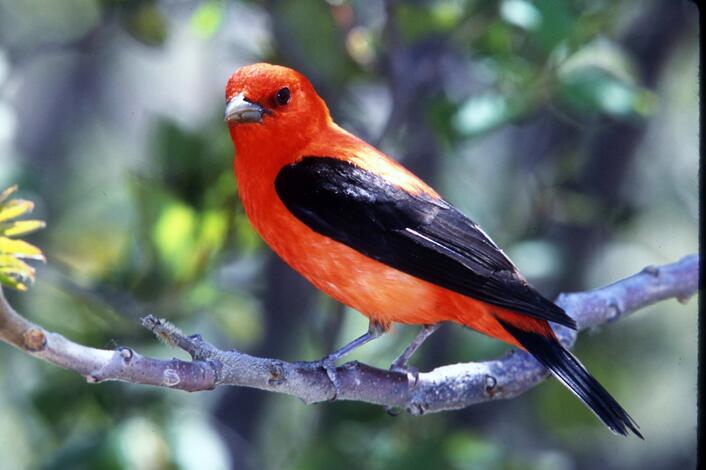
Walking the EIC’s Environmental Study Area trails, Simek gets out his binoculars and notices a Scarlet Tanager in a tree on the edge of the old rose garden. The male has a deep-colored red body with black wings; the female has more of a greenish color. He said there are a couple that reside in the EIC for the duration of summer, but most are just making a UM-Dearborn pit stop on their long flight from the Amazon to Canada.
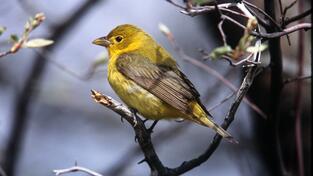
The birds stop on campus to eat insects — especially the moth caterpillars abundant on Michigan's native trees, including Oaks. This essential insect biomass is critical as migration stopover fuel.
“That’s the key — insect biomass — and we have plenty of food for them. Michigan’s native Oaks are extremely important to bird populations because they offer quite a buffet. When comparing them to how they stack up to the competition, they are at the top of the Big 10 of trees.” For comparison, Simek says a Norway Maple Tree offers just a handful of different species of moth caterpillars, while Oaks typically have hundreds.
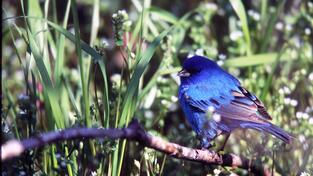
When it comes to bird viewing, Simek said the trees along the edge of the old rose garden are also home this week to the bright blue Indigo Bunting, a favorite of avid bird watchers.
“Birders visiting our natural area will sometimes ask about where they might see an Indigo Bunting, as we are a place where Indigo Buntings stop as they make their way up from wintering in Central America. I can’t guarantee that you will see specific birds because, you know, these are birds and of course birds do not stay glued to their perches, but they are definitely here.”
Songbirds you may see in the EIC’s natural areas also include the orange and black Oriole, the Thrush bird family, bright-colored Warblers and the black, white and red Rose-Breasted Grosbeak. Those birds are most often seen along the Fairlane Lake’s lakeside trail, which is accessible when you take the main log-lined trail outside of the EIC Building.
For those new to birding, Simek shares a few tips. First, wear comfortable shoes. Bonus items include: clothes with pockets, an identification guide for birds (Simek uses Peterson Field Guide to Birds of Eastern and Central North America) and a pair of binoculars. “Binoculars are one of the best tools in the bird-watching tool box. From far away, it may look like a generic bird. Binoculars help the colors jump out.”
There’s a saying that the early bird gets the worm — Simek says when it comes to bird watching, it’s true. For best bird viewing results, Simek said early morning is best. But interesting birds can be seen at all hours this time of year.
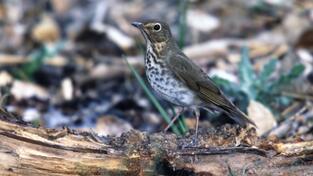
The pictured Swainson's Thrush, another long-distance Neotropical migrant that visits campus, has a bold white eye-ring, which is a field mark that assists in its identification. It also has a flute-like song. So, even if you don't see one, listening to its sound is a perk in itself.
“Hearing the birds singing their songs on a May day is really something else. So, even if you don’t want to search the trees for birds, you can still enjoy listening to the diversity of the bird life we have here.”
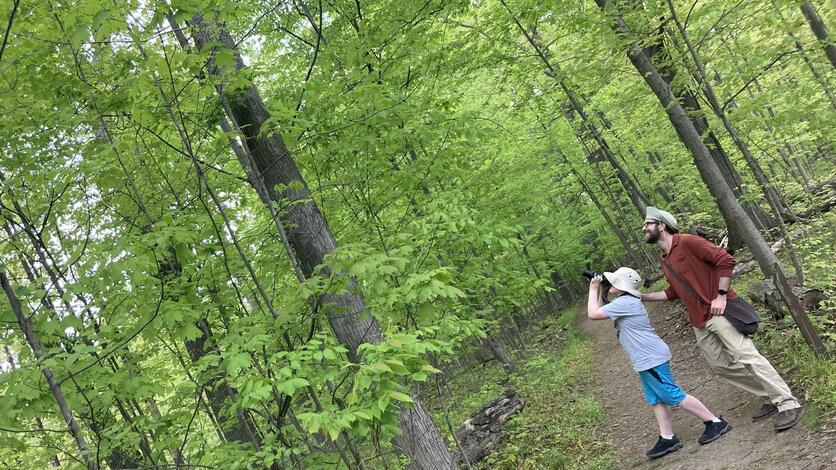
But wait, there’s more…
In addition to it being the best bird watching week, Simek says there are a few other signs of spring life you may want to see.
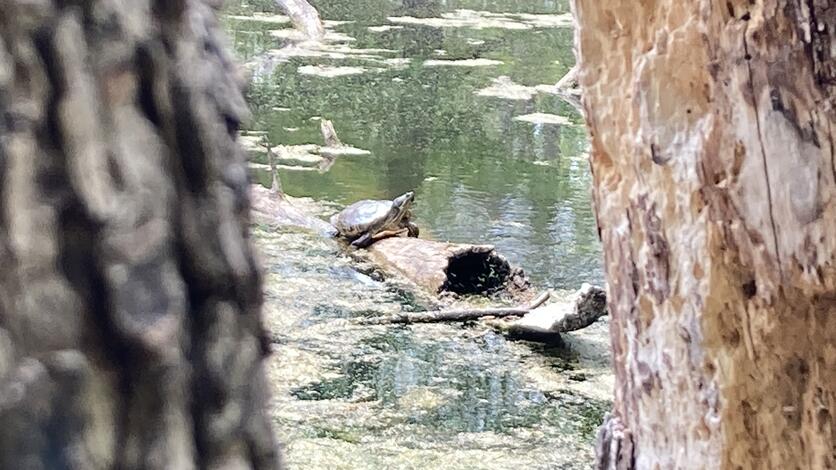
If you like turtles, they are basking on logs near the north end of Fairlane Lake — and there’s a bench there so spectators can enjoy the turtles while they relax in the sunshine too.
“At the north end of the lake, turtles line up on logs — shell room only. Since they are cold-blooded, they need the sun to warm them up when the water is colder than the air because it helps them digest their food better and be more active,” he said. “So, if you want to see turtles, hang out there. And sit on the bench so you can do a little basking of your own.”
While walking by the lake, Simek says you might hear the croaks of American toads — which give a bird-like trill — and bullfrogs, which sound like they are saying “jug of rum.”
Spring flowers are in abundance too.
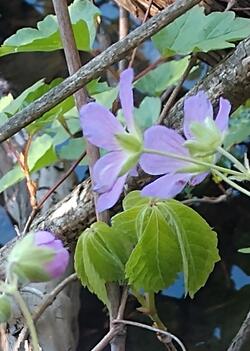
Purple wild geraniums are seen throughout the natural areas. To help pollinators find their way to the nectar reward, these wildflowers have lines on their petals. You can see the lines with a magnifying glass or — this is a tip Simek gives — by flipping over binoculars and looking through the opposite end.
Mayapples, which look like foot-long umbrellas sticking out of the ground, are seen from the trail. These unique plants have flowers that look like apple blossoms under their leaf canopy.
Simek says nature’s sights and sounds will continue to surprise and delight as spring turns into summer. There’s always something new to see and learn, but Simek says trail walks offer more than education — they have mental and physical health benefits too. “Sometimes an outdoor walk is just what the body, mind and soul needs.”
Simek said the trails open to the public daily from sunrise to sunset. Masks are not required as it is outdoors, but you are encouraged to bring one. Simek would also like to remind nature-goers that fishing on site is prohibited and to leave bikes and dogs at home because they cause disruption and stress to the Natural Area wildlife (and to fellow trail walkers).
To celebrate the EIC, there will be a 20th anniversary celebration on Friday, May 21, 4 p.m., and Professor Emeritus Orin Gelderloos will give his Legacy Lecture, reflecting on a career well spent. If you’d like to attend the virtual event, please register here.
Story by Sarah Tuxbury.



